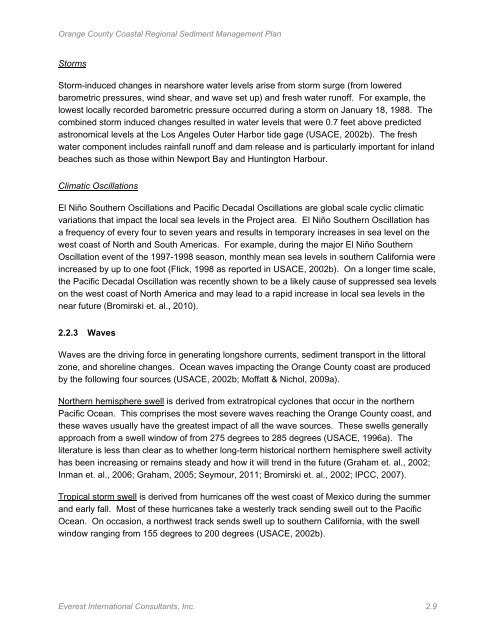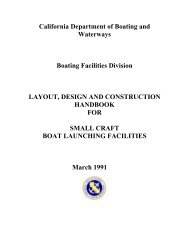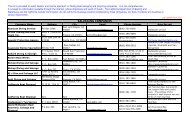EVEREST June, 2013 - California Department of Boating and ...
EVEREST June, 2013 - California Department of Boating and ...
EVEREST June, 2013 - California Department of Boating and ...
Create successful ePaper yourself
Turn your PDF publications into a flip-book with our unique Google optimized e-Paper software.
Orange County Coastal Regional Sediment Management Plan<br />
Storms<br />
Storm-induced changes in nearshore water levels arise from storm surge (from lowered<br />
barometric pressures, wind shear, <strong>and</strong> wave set up) <strong>and</strong> fresh water run<strong>of</strong>f. For example, the<br />
lowest locally recorded barometric pressure occurred during a storm on January 18, 1988. The<br />
combined storm induced changes resulted in water levels that were 0.7 feet above predicted<br />
astronomical levels at the Los Angeles Outer Harbor tide gage (USACE, 2002b). The fresh<br />
water component includes rainfall run<strong>of</strong>f <strong>and</strong> dam release <strong>and</strong> is particularly important for inl<strong>and</strong><br />
beaches such as those within Newport Bay <strong>and</strong> Huntington Harbour.<br />
Climatic Oscillations<br />
El Niño Southern Oscillations <strong>and</strong> Pacific Decadal Oscillations are global scale cyclic climatic<br />
variations that impact the local sea levels in the Project area. El Niño Southern Oscillation has<br />
a frequency <strong>of</strong> every four to seven years <strong>and</strong> results in temporary increases in sea level on the<br />
west coast <strong>of</strong> North <strong>and</strong> South Americas. For example, during the major El Niño Southern<br />
Oscillation event <strong>of</strong> the 1997-1998 season, monthly mean sea levels in southern <strong>California</strong> were<br />
increased by up to one foot (Flick, 1998 as reported in USACE, 2002b). On a longer time scale,<br />
the Pacific Decadal Oscillation was recently shown to be a likely cause <strong>of</strong> suppressed sea levels<br />
on the west coast <strong>of</strong> North America <strong>and</strong> may lead to a rapid increase in local sea levels in the<br />
near future (Bromirski et. al., 2010).<br />
2.2.3 Waves<br />
Waves are the driving force in generating longshore currents, sediment transport in the littoral<br />
zone, <strong>and</strong> shoreline changes. Ocean waves impacting the Orange County coast are produced<br />
by the following four sources (USACE, 2002b; M<strong>of</strong>fatt & Nichol, 2009a).<br />
Northern hemisphere swell is derived from extratropical cyclones that occur in the northern<br />
Pacific Ocean. This comprises the most severe waves reaching the Orange County coast, <strong>and</strong><br />
these waves usually have the greatest impact <strong>of</strong> all the wave sources. These swells generally<br />
approach from a swell window <strong>of</strong> from 275 degrees to 285 degrees (USACE, 1996a). The<br />
literature is less than clear as to whether long-term historical northern hemisphere swell activity<br />
has been increasing or remains steady <strong>and</strong> how it will trend in the future (Graham et. al., 2002;<br />
Inman et. al., 2006; Graham, 2005; Seymour, 2011; Bromirski et. al., 2002; IPCC, 2007).<br />
Tropical storm swell is derived from hurricanes <strong>of</strong>f the west coast <strong>of</strong> Mexico during the summer<br />
<strong>and</strong> early fall. Most <strong>of</strong> these hurricanes take a westerly track sending swell out to the Pacific<br />
Ocean. On occasion, a northwest track sends swell up to southern <strong>California</strong>, with the swell<br />
window ranging from 155 degrees to 200 degrees (USACE, 2002b).<br />
Everest International Consultants, Inc. 2.9




